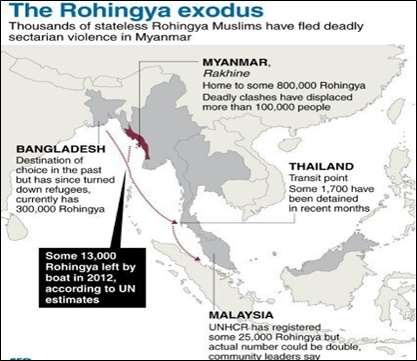India’s policy on the Rohingyas
- Posted By
10Pointer
- Categories
Polity & Governance
- Published
22nd Aug, 2022
-
-
Context
- India’s approach towards refugees, in general about the Rohingyas has raised several questions about India’s policy on the Rohingyas. It has led to the politicization of the issue.
-
About
Who are Rohingya?
- The Rohingya people are a stateless Indo-Aryan ethnic group who predominantly follow Islam and reside in Rakhine State, Myanmar (previously known as Burma).
- They are prescribed by the United Nations as the most persecuted minority in the world.
- They fled their homes in 2017 to escape an alleged crackdown by Myanmar’s military.
- To escape discrimination and violence in Myanmar, minority Rohingya Muslims have for decades fled from the Buddhist-majority country to neighboring Bangladesh and other countries, including India.

-
What is the issue?
- In June 2021, a fire ravaged one of the Rohingya camps and after the incident displaced Rohingya were moved to an empty plot nearby that belonged to the Zakat Foundation of India, an NGO.
- It was later decided by the Delhi government to shift all Rohingya families to EWS flats and would be put under constant police watch.
- Foreigners Regional Registration Office (FRRO) is responsible for tracking foreigners and their visas. The FRRO is under the administrative control of the MHA. Since Delhi is a Union Territory, law and order are under the Central government, it has erupted the matter of managing the refugee issues pertaining to Rohingyas between the Delhi Government and the Central Government.
-
When did the Rohingya came to India?
- India allowed Rohingya refugees to enter the country in 2012 and considered the eruption of violent conflicts between Rakhine Buddhists and Rohingya Muslims in Rakhine State as an “internal affair”.
- Myanmar has classified them as “resident foreigners” or “associate citizens,”. They were forced to leave Myanmar in large numbers after several waves of violence, which first began in 2012.
- Officially, about 1,200 Rohingya have been identified as among the first batch to have arrived in Delhi in 2012.
-
Where do the Rohingya live in Delhi?
- The detention center at Sarai Rohilla and Seva Sadan deportation center in Lampur are the two Delhi government facilities where Rohingyas who are believed to be in India illegally are rounded up and kept.
- Other than this, Rohingya live in hutments in the densely populated Kalindi Kunj and Madanpur Khadar areas in Delhi which are contiguous with Uttar Pradesh.
-
Nature of assistance provided to Rohingyas in the detention camps:
- Relief assistance is provided by the Centre that includes monthly cash dole, subsidized ration, clothing materials, utensils, cremation and shradh (last rites) grants, and infrastructure facilities in camps.
-
What is India’s stand on refugees?
- According to the government the infiltration from the Rakhine State of Myanmar into Indian territory, besides being a burden on the limited resources of the country also aggravates the security challenges posed to the country.
- In addition, the rise in terrorism in the last few decades is a cause for concern in most nations and those illegal migrants are more vulnerable to getting recruited by terrorist organizations.
- India is not a signatory to the 1951 UN Convention relating to the Status of Refugees and the 1967 Protocol.
- All foreign undocumented nationals are governed as per the provisions of:
- The Foreigners Act, 1946
- The Registration of Foreigners Act, 1939
- The Passport (Entry into India) Act, 1920
- The Citizenship Act, of 1955
- Foreign nationals who enter the country without valid travel documents are treated as illegal immigrants.
- There is no national law on refugees at present. Only Standard Operating Procedures are issued by the MHA to deal with foreign nationals in India, who claim to be refugees.
-
What is the process of deportation?
- Illegal immigrants are detected, detained, and deported under provisions of the Passport Act, 1920 or the Foreigners Act, 1946.
- The powers to identify and deport them have also been delegated to State governments and Union Territories.
- Once a ‘foreigner’ has been apprehended by the police for staying illegally, without any document, he or she is produced before the local court.
- If the accused is found guilty, they can be imprisoned for three months to eight years. After completing their sentence, the court orders deportation.
- Later, the foreign inmates are moved to detention centers till the country of origin verifies and accepts them.
-
Conclusion
- India doesn't have a National Law on refugees at present and it was made clear by Rijiju (Minister of Law and Justice) in an address to the Lok Sabha. It is creating a vacuum, leaving enough legroom for political parties to turn the issue into a politicized one.
- As India is a non-signatory to the 1951 UN Convention, we should honor the universally respected principle of non-refoulement. Refugees need to be looked after as these reconciliation procession needs time and effort while ensuring all the dimensions of India’s internal security and mitigating threats if any.
